AMD Athlon 64 4000+ & FX-55: A Thorough Investigation
by Anand Lal Shimpi on October 19, 2004 1:04 AM EST- Posted in
- CPUs
Microsoft Office XP SP-2
Here we see in that the purest of office application tests, performance doesn't vary all too much. The spread of performance here is around 6%, which is nothing terribly significant. While AMD continues to top the charts, Intel is basically on par with them here.
For doing the most basic work in Office, you'll find no real performance difference between a top of the line Intel and AMD machine. Head towards the mid range and you'll still find no real difference in performance, only in price.
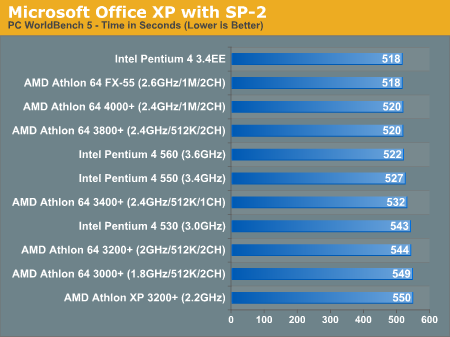
Mozilla 1.4
Quite possibly the most frequently used application on any desktop is the one we pay the least amount of attention to when it comes to performance. While a bit older than the core that is now used in Firefox, performance in Mozilla is worth looking at as many users are switching from IE to a much more capable browser on the PC - Firefox.
Here it's no secret that AMD is clearly on top in performance. What's
truly impressive is that the fastest Athlon 64 is able to complete the Mozilla
test in close to half the time of the Pentium 4 550. The performance advantage
the Athlon 64s hold over the Pentium 4s is impressive to say the least.
We continue to see that a dual channel setup gives the Athlon 64 around
a 5% performance boost. What is quite interesting is the 11% performance
improvement
thanks to a 1MB L2 cache that the 4000+ holds over the 3800+. What
this confirms is that the low memory access latencies provided for
by the
on-die memory
controller
of the Athlon 64 is largely responsible for the performance advantage
here. Looking at the 3.4EE we see that its large L3 cache is able to
make up
for the clock speed deficit, giving it the lead over the Pentium 4
560, further
confirming our statements on what matters when it comes to browser
performance.
Low latency memory accesses matter most here and AMD takes the crown. It is worth noting that you are generally going to be limited by the speed of your Internet connection when it comes to browser performance, however it is always nice to have the snappiest browser experience possible.
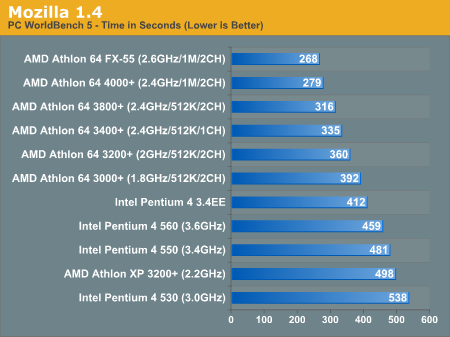
ACD Systems ACDSee PowerPack 5.0
ACDSee is a popular image editing tool that is great for basic image editing options such as batch resizing, rotating, cropping and other such features that are too elementary to justify purchasing something as powerful as Photoshop for. There are no extremely complex filters here, just pure batch image processing.
At 2.4GHz, AMD begins to take the lead from Intel, outperforming even the 3.4EE. The higher up the model number goes, the greater the gap continues to be. There isn't much of a performance difference between the three 2.4GHz chips from AMD, with the biggest difference actually being between the Athlon 64 3800+ and 3400+, or dual vs. single channel memory configurations for those feeling overwhelmed by model numbers. More cache doesn't seem to do much here, as these sorts of operations are largely bandwidth limited and exhibit very little temporal locality with respect to their datasets. We see a 6% gain in performance thanks to the dual channel memory controller of AMD's Socket-939 parts, which is about in line with what we've seen across the board.
The Pentium 4 530 does quite abysmally here, falling behind even the older Athlon XP 3200+. The rest of the Prescott line does appear to do much more reasonably, although at much higher prices than better performing AMD chips.

Ahead Software Nero Express 6.0.0.3
While it was a major issue in the past, these days buffer underrun errors while burning a CD or DVD are few and far between thanks to high performance CPUs as well as vastly improved optical drives. When you take the optical drive out of the equation, how do these CPU's stack up with burning performance?
As you'd guess, they're all pretty much the same, with the slight variations between chips falling within expectations. Any of these chips will do just fine.
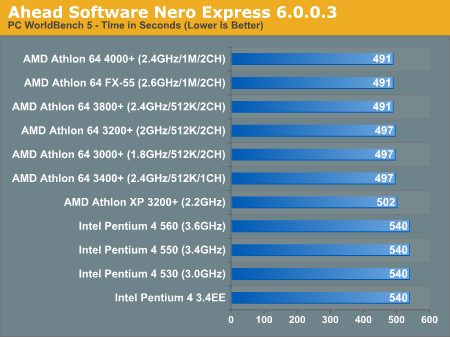
Winzip
Archiving performance ends up being fairly CPU bound as well as I/O limited. Here we continue to see AMD at the top of the charts, closely followed by the high end Intel chips. There's still a 5% performance difference between the single and dual channel 2.4GHz Athlon 64s, which we've been seeing over and over again. We don't see much of a performance boost with the 1MB cache of the 4000+, but the FX-55 does manage to slightly differentiate itself with its higher operating clock.
The Athlon XP does surprisingly well in this test, holding its own against the lower end Athlon 64s.
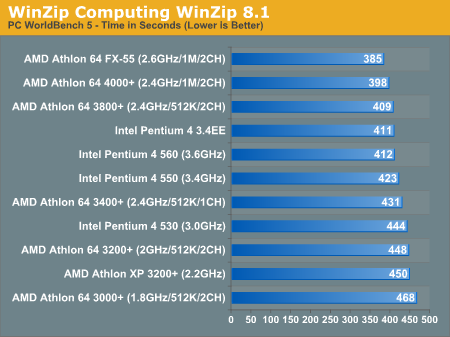
WinRAR 3.40
Pulling the hard disk out of the equation we can get a much better idea of which processors are truly best suited for file compression. While the hard drive hid a lot of the shortcomings of the Athlon XP in WorldBench's WinZip test, they are all revealed in WinRAR's built in benchmark that is largely disk I/O independent.
Here the Athlon 64s show a huge advantage over the Pentium 4 processors, with the slowest Athlon 64 outperforming the fastest Pentium 4 Extreme Edition. The real world performance implications are somewhere in between what we've shown with WorldBench 5's WinZip test and the built-in WinRAR benchmark, needless to say the victor continues to be AMD's Athlon 64.
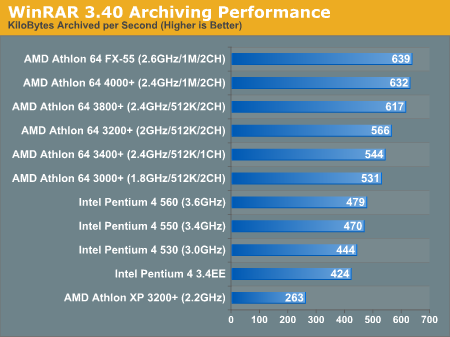










89 Comments
View All Comments
coolme - Monday, January 10, 2005 - link
#85 yeah, but when comparing to Tom's Hardware review, it's totally off track... (Tom's is more believeble because there is pics of how he measured it and based on the fact that there is no way a A64 could handle 200+ watts)http://www6.tomshardware.com/cpu/20041115/pentium4...
how Tom tested it: http://www6.tomshardware.com/cpu/20041115/pentium4...
eight - Monday, December 27, 2004 - link
Has anyone information about A64 performance with Premiere Pro 1.5? I assume thet A64 does beat P4, but assumption is mother of... :)euanw - Tuesday, November 9, 2004 - link
#44Wesley,
I am very impressed by your articles. Can you inform me of the procedure you used to overclock the FX55? With the Neo2 board I am not clear on CPU vid and CPU voltage, what do they mean? When I change the multiplier to 13.5 my new PC reaches winXP and then reboots.
My setup is MSI K8N-Neo2-54G, FX-55, 2 x 512MB - OCZ EL DDR PC-3200 Platinum Rev2, Nvidia Quadro FX3000, 2x Seagate Barracuda 7200.7 120 GB, Matrox RTX-100 real time video editor, Antec TrueBlue 480W ATX-12V, BenQ DVD Dual DW1610, WinXP-SP2.
euanw - Tuesday, November 9, 2004 - link
#44Wesley,
Gioron - Sunday, October 24, 2004 - link
While I'm unsure of the exact method used in this review, I'm sure that there is no built-in power measurement devices on the motherboards and processors listed (unless its new and no one told me...) so its NOT just just a matter of installing software that can read a sensor thats already there (as in all the CPU temp monitors). This means it requires some hardware to measure the voltage and current flow to various components (or you can cheat a little and assume the voltage is constant and just measure current).Unfortunately, this is not as easy as it sounds, since isolating various components can be a problem. Its fairly easy to measure things like hard drive power useage since there is only one power connector going to it and its easy to access, so you measure the current on the 5v line and the current on the 12v line, and you're pretty much done. Things like CPUs, motherboards and graphics cards are a bit more difficult. On the newer graphics cards you can measure the power consumption from the additional molex connector, but in all likelyhood, the card will also draw a certain amount of power from the AGP slot power lines, and no one in their right mind is going to unsolder the AGP slot and raise it half an inch in an attempt to put a current sensor in line with the power leads. Thus, you need to rely on indirect means and educated guesses. You can measure the current going into the motherboard, but how much of that is going to the chipset, the CPU, the RAM and the graphics card? You can swap in a different CPU and see how it changes, but that won't give you absolute readings. You can try to remove the CPU and see what power the MB uses without one, but odds are it'll use more power when its actually interfacing with a CPU instead of beeping error codes at you.
Bottom line: There is no easy way to measure power consumption, and even dedicated hardware review sites have problems with it. Personally, I trust Anand far enough that I'm sure he didn't completely screw it up, and the numbers he has are probably close enough to the real thing. I'd forget about measuring power for myself.
xsilver - Friday, October 22, 2004 - link
Kinda late on the comments but..If anand or anybody can answer -- what is used to measure the "power consumption" software? or hardware? links? I would like to test this myselfthanks
Bakwetu - Friday, October 22, 2004 - link
Whoah, it's been a while since I checked out cpu reviews and I must say Amd has some impressive cpu:s nowadays. Even though I am budget oriented when it comes to buying hardare, I'd choose the 3400+ model before the 3200+, it's not all that much more expensive and seems to perform much bettert - Friday, October 22, 2004 - link
79uhuh.... and in a server type situation, how many raid arrays are ran off the chipset controllers? not many i would wager..
hell... u prolly have an independent fibre optic raid array :)
hardware, baby, hardware.
t.
knitecrow - Friday, October 22, 2004 - link
I always knew women were trouble when it comes to technology ;)screech - Thursday, October 21, 2004 - link
nice ones #79, 78. :)